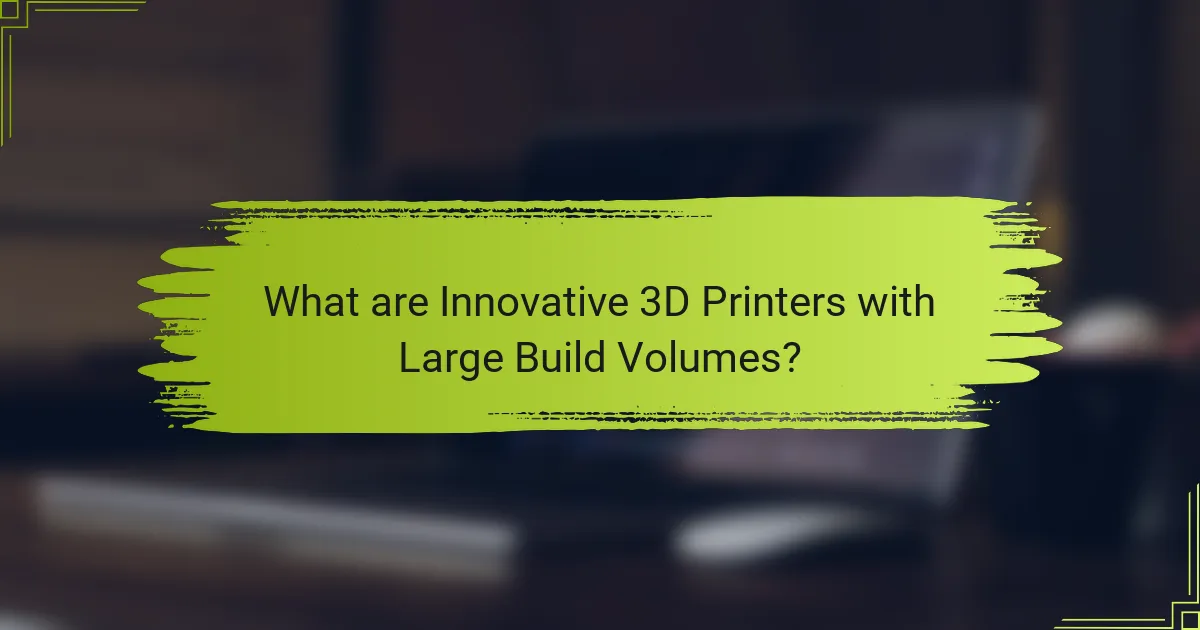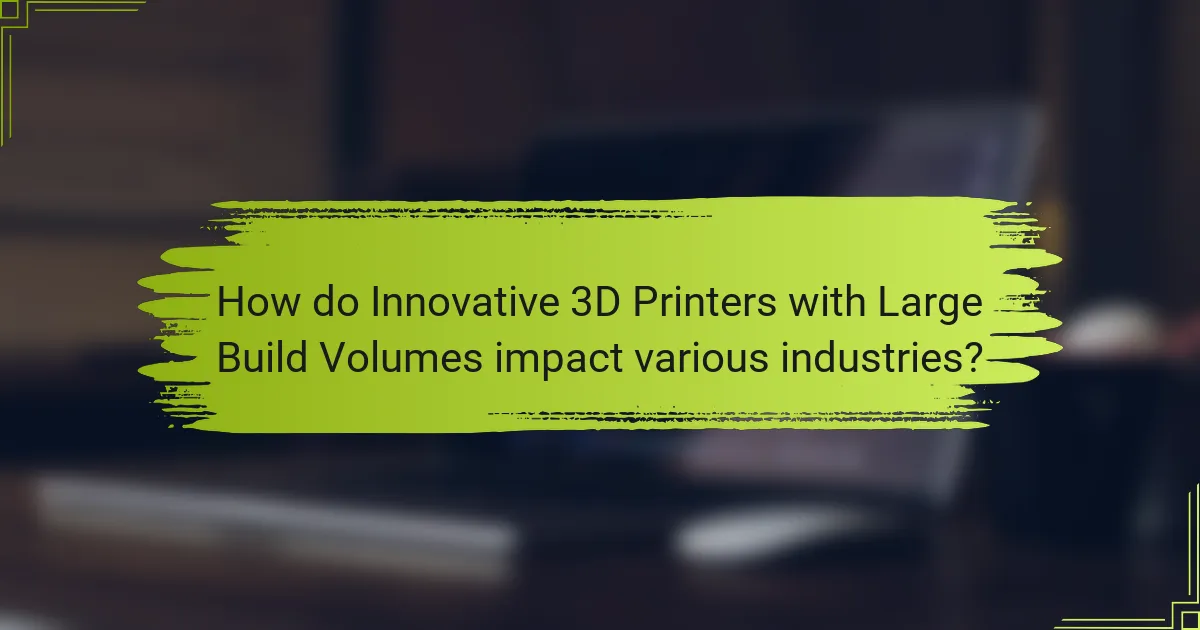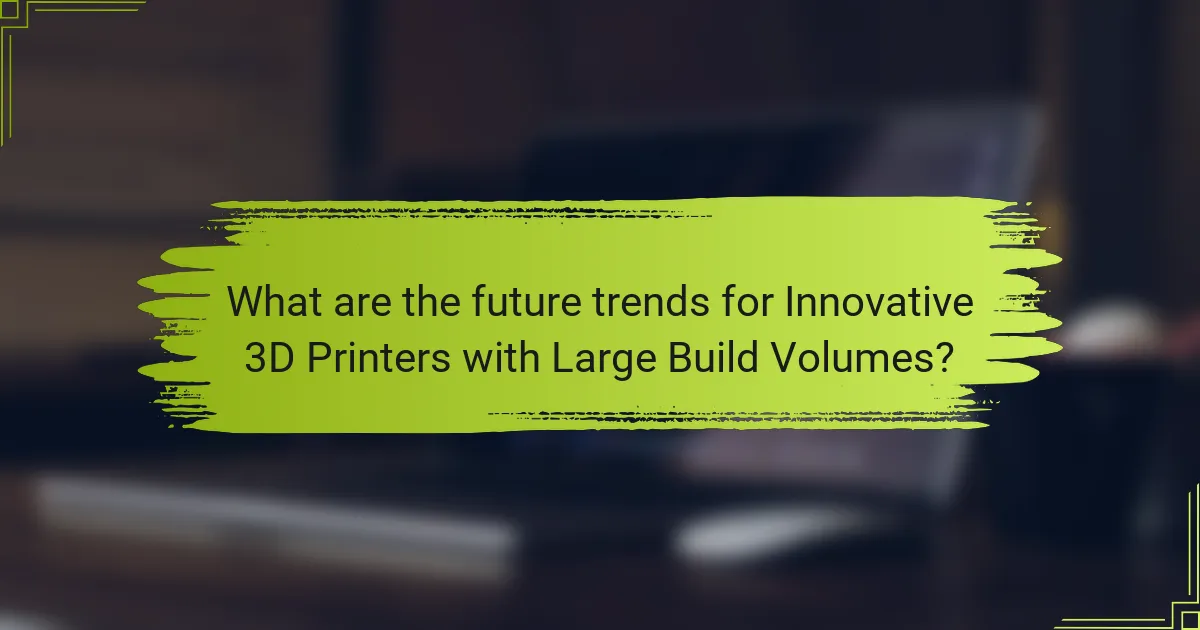
What are Innovative 3D Printers with Large Build Volumes?
Innovative 3D printers with large build volumes are advanced machines designed to create large-scale objects. These printers typically feature expansive print areas, often exceeding 1 meter in each dimension. They utilize various technologies, including FDM (Fused Deposition Modeling) and SLA (Stereolithography). Large build volume printers are ideal for industries such as aerospace, automotive, and architecture. They enable the production of prototypes, molds, and end-use parts. Some models can print multiple items simultaneously, increasing efficiency. Notable examples include the BigRep ONE and the Raise3D Pro 2 Plus. These printers enhance design possibilities and reduce production times significantly.
How do these printers differ from standard 3D printers?
Innovative 3D printers with large build volumes differ from standard 3D printers primarily in their size and capabilities. These printers can create larger objects due to their expanded build area. Standard 3D printers typically have limited dimensions, often constraining the size of printed items. Large volume printers also often utilize advanced technologies such as multi-material printing and faster production speeds. This allows for more complex designs and quicker project completion. Additionally, they may feature enhanced stability and precision due to their robust construction. Overall, their unique attributes enable them to cater to industrial applications and larger projects that standard 3D printers cannot accommodate.
What defines a large build volume in 3D printing?
A large build volume in 3D printing is defined by the maximum dimensions that a 3D printer can accommodate for printing objects. Typically, a build volume exceeding 300 mm x 300 mm x 300 mm is considered large. This allows for the creation of larger parts or multiple smaller items in a single print job. Larger build volumes enable more complex designs and reduce the need for assembly. For example, industrial 3D printers often feature build volumes of 1000 mm or more in any dimension. This capability is essential for applications in aerospace, automotive, and architecture, where large components are frequently required.
What are the common technologies used in these printers?
Common technologies used in innovative 3D printers include Fused Deposition Modeling (FDM), Stereolithography (SLA), and Selective Laser Sintering (SLS). FDM utilizes a thermoplastic filament that is heated and extruded layer by layer. SLA employs a liquid resin cured by a UV laser to form solid layers. SLS uses a laser to fuse powdered material into a solid structure. Each technology has unique advantages. FDM is cost-effective and widely accessible. SLA offers high precision and detail for intricate designs. SLS provides strength and durability suitable for functional parts. These technologies enable diverse applications in various industries.
What are the key features of Innovative 3D Printers with Large Build Volumes?
Innovative 3D printers with large build volumes feature expansive printing areas. These printers can create larger objects in a single print job. They often utilize advanced materials for enhanced durability. Precision and resolution are maintained even at larger scales. Many models incorporate multi-material printing capabilities. User-friendly interfaces enhance the printing experience. Some printers offer automated calibration for accuracy. High-speed printing technology reduces production time. These features collectively enable efficient and versatile manufacturing solutions.
How does print speed impact the efficiency of large volume printers?
Print speed significantly affects the efficiency of large volume printers. Higher print speeds lead to reduced production time for large projects. This enables quicker turnaround times for clients and enhances workflow efficiency. Additionally, faster printing can decrease operational costs by minimizing labor and energy consumption. For instance, a study by the American Society of Mechanical Engineers found that increasing print speed by 30% can improve productivity by up to 25% in industrial settings. Therefore, optimizing print speed is crucial for maximizing the overall performance of large volume printers.
What materials can be used with these printers?
Innovative 3D printers with large build volumes can use various materials. Common materials include PLA, ABS, PETG, and nylon. Each material offers distinct properties for different applications. For instance, PLA is biodegradable and easy to print. ABS is durable and heat-resistant, making it suitable for functional parts. PETG combines the best of both PLA and ABS, providing strength and flexibility. Nylon is known for its toughness and is often used in industrial applications. These materials enable versatility in 3D printing projects, catering to both hobbyists and professionals.
What benefits do Innovative 3D Printers with Large Build Volumes provide?
Innovative 3D printers with large build volumes offer significant advantages. They enable the production of larger parts in a single print, reducing assembly time. This feature enhances efficiency in manufacturing processes. Additionally, they allow for the creation of complex geometries that may not be possible with smaller printers. Larger build volumes also facilitate the use of advanced materials that require more space for effective printing. According to a study by Wohlers Associates, large-format 3D printing can lead to cost savings by minimizing material waste. These printers are particularly beneficial in industries such as aerospace and automotive, where large components are common.
How do these printers enhance production capabilities?
Innovative 3D printers with large build volumes enhance production capabilities by allowing the creation of larger and more complex parts in a single print job. This reduces the need for assembly, streamlining the manufacturing process. They enable faster production times due to increased print area, which can accommodate multiple parts simultaneously. These printers often utilize advanced materials, expanding the range of applications. Their precision and reliability improve product quality and reduce waste. According to a study by Wohlers Associates, the adoption of large-format 3D printing has increased production efficiency by up to 50% in some industries.
What cost savings can be achieved with large build volume printing?
Large build volume printing can achieve significant cost savings primarily through reduced material waste. By printing larger parts in a single run, manufacturers minimize the need for multiple setups and material handling. This efficiency can lead to lower labor costs associated with setup and post-processing.
Additionally, large build volumes allow for the production of multiple components simultaneously. This capability can decrease production time and enhance throughput. According to a study by Wohlers Associates, companies using large format 3D printing can reduce production costs by up to 30% compared to traditional manufacturing methods.
Furthermore, the ability to create complex geometries in one piece eliminates the need for assembly, which further cuts costs. Overall, large build volume printing streamlines production processes, resulting in substantial financial benefits.

How do Innovative 3D Printers with Large Build Volumes impact various industries?
Innovative 3D printers with large build volumes significantly impact various industries by enabling the production of larger and more complex parts. These printers allow for the creation of prototypes and end-use products in a single print, reducing assembly time and costs. Industries such as aerospace benefit from lightweight components that improve fuel efficiency. The automotive industry utilizes large 3D printers for custom parts and tooling, enhancing design flexibility. In construction, large-scale 3D printing can produce entire structures quickly, minimizing labor and material waste. The medical field leverages this technology for custom implants and prosthetics tailored to individual patients. According to a report by Wohlers Associates, the additive manufacturing market is expected to grow to $35.6 billion by 2024, highlighting the increasing adoption of these printers across sectors.
Which industries are most likely to benefit from these printers?
The industries most likely to benefit from innovative 3D printers with large build volumes include aerospace, automotive, healthcare, and construction. Aerospace companies use these printers to create lightweight components, reducing fuel consumption. Automotive manufacturers leverage large build volumes for prototyping and producing complex parts efficiently. Healthcare providers utilize them for custom implants and prosthetics tailored to individual patients. The construction industry benefits from 3D printing by creating large-scale structures and components quickly and cost-effectively. Each of these industries experiences significant improvements in production speed, material efficiency, and design flexibility due to the capabilities of large-volume 3D printers.
How is the automotive industry leveraging large build volume 3D printing?
The automotive industry is leveraging large build volume 3D printing to produce parts more efficiently. This technology allows manufacturers to create larger components in a single print, reducing assembly time. Companies like Ford and BMW are using this method for prototyping and tooling. It enables rapid iteration and testing of designs, improving innovation speed. Additionally, large build volume 3D printing reduces material waste compared to traditional methods. According to a study by the American Society of Mechanical Engineers, this process can cut production costs by up to 50%. Overall, large build volume 3D printing enhances production capabilities in the automotive sector.
What role do these printers play in the aerospace sector?
Innovative 3D printers with large build volumes play a significant role in the aerospace sector. They enable the production of lightweight, complex components that traditional manufacturing methods cannot achieve. These printers facilitate rapid prototyping, reducing the time from design to production. They also allow for customization of parts, meeting specific aerospace requirements. The use of advanced materials in 3D printing enhances the durability and performance of aerospace components. According to a study by Wohlers Associates, 3D printing can reduce material waste by up to 90%. This efficiency is crucial in an industry focused on sustainability and cost reduction. Overall, large build volume 3D printers are transforming aerospace manufacturing processes.
What challenges do users face when adopting these printers?
Users face several challenges when adopting innovative 3D printers with large build volumes. One significant challenge is the high initial cost of these printers. Many large build volume printers are priced significantly higher than standard models. This can deter small businesses or hobbyists from making the investment.
Another challenge is the complexity of operation. Users may require advanced knowledge of 3D printing technology to operate these machines effectively. This includes understanding software for design and slicing.
Material compatibility also poses a challenge. Not all materials can be used with large volume printers, limiting options for users. Additionally, print quality can vary based on the chosen material.
Maintenance and troubleshooting can be difficult. Large printers often require more frequent maintenance due to their size and complexity. Users may struggle with issues like bed leveling and nozzle clogs.
Lastly, space requirements are a concern. These printers typically need more physical space compared to smaller models. Users may not have adequate room in their work environment to accommodate these larger machines.
How can users overcome the learning curve associated with large volume printers?
Users can overcome the learning curve associated with large volume printers by utilizing comprehensive training resources. Manufacturers often provide detailed manuals and online tutorials. Engaging with community forums can offer practical insights from experienced users. Hands-on practice with smaller projects can build confidence. Regularly updating software ensures access to the latest features and fixes. Attending workshops or webinars can enhance understanding of advanced functionalities. Utilizing troubleshooting guides can help resolve common issues efficiently. Lastly, consistent experimentation with different materials can broaden users’ skills and adaptability.
What maintenance considerations should be taken into account?
Regular maintenance is crucial for innovative 3D printers with large build volumes. It ensures optimal performance and longevity of the equipment. Key considerations include regular cleaning of print heads and build plates to prevent residue buildup. Calibration of the printer is essential to maintain accuracy in dimensions and print quality. Checking and replacing worn-out parts, such as belts and nozzles, is necessary to avoid print failures. Monitoring the software for updates can enhance functionality and security. Additionally, ensuring proper storage conditions for materials prevents degradation. Following the manufacturer’s guidelines for maintenance schedules can extend the printer’s lifespan significantly.

What are the future trends for Innovative 3D Printers with Large Build Volumes?
Future trends for innovative 3D printers with large build volumes include enhanced material versatility and improved speed. Manufacturers are focusing on developing printers capable of using a wider range of materials, including composites and bio-based options. This trend is driven by the demand for more complex and durable products.
Additionally, advancements in print speed are expected to significantly reduce production times. Companies are implementing faster extrusion technologies and multi-nozzle systems. This will enable faster prototyping and production in various industries.
Automation and smart technology integration are also emerging trends. These innovations will allow for real-time monitoring and adjustments during the printing process. This leads to higher precision and reduced waste.
Sustainability is becoming a key focus in the development of large-volume printers. Efforts are being made to create energy-efficient machines and utilize recycled materials. This aligns with global initiatives to reduce environmental impact.
Finally, the rise of on-demand manufacturing is influencing the market. Businesses are increasingly adopting large-volume 3D printing for customized production. This shift is expected to alter traditional supply chain dynamics significantly.
How is technology evolving in the realm of large volume 3D printing?
Technology in large volume 3D printing is advancing rapidly. New materials are being developed to enhance strength and flexibility. Innovations in printer design allow for larger build volumes, increasing production capabilities. Improved software algorithms streamline the printing process, enhancing precision. Multi-material printing technology is emerging, enabling complex designs. Automation and robotics are integrating into 3D printing workflows, boosting efficiency. Research indicates that these advancements lead to reduced production times and costs. Industry leaders are investing heavily in these technologies, signaling a strong market growth trajectory.
What advancements are expected in materials used for 3D printing?
Advancements in materials for 3D printing include the development of high-performance polymers and metal alloys. These materials offer enhanced strength and durability compared to traditional options. For example, new thermoplastics are being engineered to withstand higher temperatures and stress. Additionally, bio-based and biodegradable materials are gaining traction for sustainable printing solutions. Innovations in composite materials are also emerging, allowing for lightweight yet strong structures. Research indicates that these advancements can improve the efficiency and applications of 3D printing in various industries. Notably, the integration of smart materials is expected to enable self-healing and adaptive properties in printed objects.
What practical tips can users follow to maximize the benefits of these printers?
To maximize the benefits of innovative 3D printers with large build volumes, users should ensure proper calibration. Accurate calibration enhances print quality and reduces errors. Users should also select the right materials for their projects. Different materials can affect the strength and appearance of the final product.
Maintaining a clean print bed is crucial for adhesion and print success. Regularly cleaning the bed prevents issues during printing. Users should also monitor print settings closely. Adjusting speed and temperature can lead to better results.
Utilizing slicing software effectively is important. Good software optimizes print paths and reduces material waste. Finally, users should regularly update firmware. Updates can improve printer performance and add new features.
How can users optimize their printer settings for better results?
Users can optimize their printer settings by adjusting parameters such as layer height, print speed, and temperature. Lowering the layer height improves detail and surface finish. Reducing print speed enhances adhesion and accuracy. Setting the correct nozzle temperature ensures proper filament flow. Users should also calibrate the printer regularly for best results. Proper bed leveling prevents warping and enhances first layer adhesion. Experimenting with different infill percentages can balance strength and material usage. Lastly, utilizing the right filament type can significantly impact print quality.
What best practices should be followed for post-processing large prints?
Post-processing large prints involves several best practices. First, ensure proper cooling of the print to avoid warping. This can be achieved by allowing the print to rest in a controlled environment. Second, carefully remove support structures using appropriate tools. This minimizes damage to the print surface. Third, sand the print edges to achieve a smooth finish. Use progressively finer grit sandpaper for optimal results. Fourth, apply a primer or sealant to enhance the surface quality. This step improves paint adhesion if coloring is desired. Lastly, perform any necessary assembly in a dust-free environment to maintain print integrity. Following these practices ensures high-quality results in large prints.
Innovative 3D printers with large build volumes are advanced machines that enable the creation of large-scale objects, often exceeding 1 meter in size. These printers utilize technologies such as FDM and SLA, making them suitable for industries like aerospace, automotive, and architecture. Key features include expansive print areas, multi-material capabilities, and enhanced speed, which significantly improve production efficiency and reduce assembly time. The article also explores the challenges users face, maintenance considerations, and future trends in large-volume 3D printing, highlighting its transformative impact across various sectors.